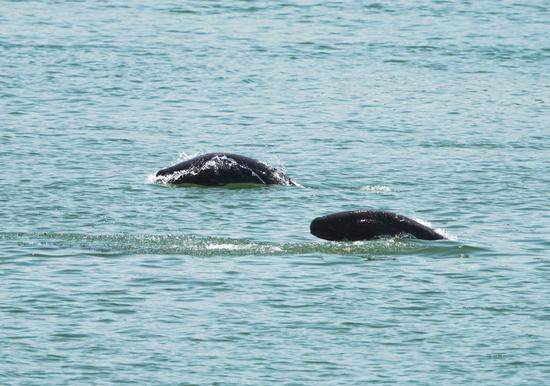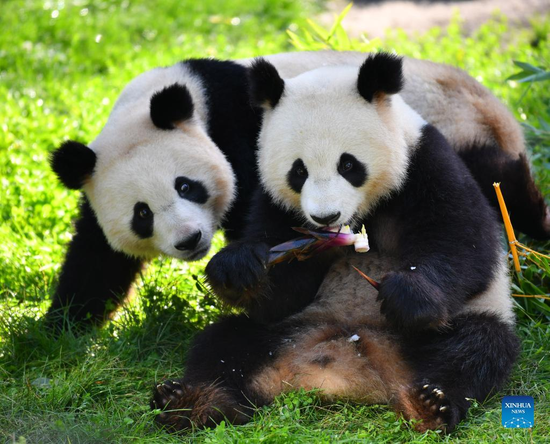An assessment report on the endangered status of primates in China was released on Tuesday, indicating that the white-handed gibbon and northern white-cheeked gibbon have not been seen in the wild in the past few decades, meeting the criteria for being declared extinct in the wild, according to ScienceNet.cn.
The report was released at a conference on Tuesday, which was also the 40th anniversary of the founding of the Endangered Species Scientific Commission of China.
A species classified as "extinct in the wild" means that it is now found only in captivity, or that it needs to be released into the wild before returning to its historic areas due to habitat loss, according to the report.
The extinction of other species such as Chinese paddlefish and dugongs has reminded people that more efforts must be made to protect endangered species, experts noted.
The researchers conducted a systematic survey of suitable habitats in and around the regions where the white-handed gibbon used to exist, but none were found and nor have they been seen or heard for at least 10 years, said Li Baoguo, the assessment expert group leader and also a professor at Xi'an-based Northwest University, according to ScienceNet.cn.
It is the same for the northern white-cheeked gibbon, according to Li.
In the past 45 years, the population of the white-handed gibbon has declined steadily due to habitat loss, hunting, and pet trading, according to the report.
Primates around the world are facing a serious situation, with more than 60 percent listed as vulnerable, endangered or critically endangered, and 75 percent have seen declining numbers, Li said.
Among the 28 remaining primate species in China, 80 percent of them are threatened, with more than 15 species having populations of less than 3,000, said Li. Also, almost all the primates inhabit scattered areas of the country, so the opportunities for inter-population breeding or genome communication are severely limited, according to Li.
Human activities are the "fundamental cause" of the unprecedented biodiversity loss, Li said, adding that other factors include invasion by alien species, overexploitation of resources, environmental pollution and global climate change. However, the root causes are rapid population growth and consumption of natural resources as well as the overutilization of biological resources, according to Li.
Li Sheng, a researcher from the School of Life Sciences at Peking University echoed the opinion. Species extinction is occurring around the world, and this is mainly caused "by human activities or human pressure," Li told the Global Times on Tuesday.
In China alone, a number of species have been declared extinct in the wild over the past few decades, including the Yangtze river dolphin, the dugong and the saiga, according to Li.
The white-handed gibbon of Southwest China's Yunnan Province had a habitat that was significantly higher than other Southeast Asia regions, ranging from 1,900 meters to 2,000 meters above sea level. However, their habitat was badly affected by deforestation in the 1950s and 1960s, according to the report.
The northern white-cheeked gibbons used to be found in southwestern parts of Yunnan, northern Laos and the northwestern part of Vietnam. In the late 1950s, the gibbons could be heard chirping in Mengla county, southern Yunnan, but their numbers dwindled in the 1970s. Even in 2011, researchers concluded that the northern white-cheeked gibbon was ecologically extinct in China, according to the report.
China has stepped up biodiversity protection efforts during recent years. The draft revision to the Law on the Protection of Wildlife was submitted in August to the National People's Congress Standing Committee for a second reading. It proposed strengthening protection for wildlife habitats and stipulated the responsibilities of governments at different levels in the conservation work, according to Xinhua News Agency.
Some species have seen a resurgence in the last 20 years, such as the giant panda, Siberian tiger and the Asian elephant, said Li Sheng.
But Li noted that we need to learn lessons from the extinctions that have occurred, and we also need to give full recognition to the efforts and achievements of conservation and sum up the experience to better guide future species protection and ecosystem restoration work.
In recent years, China has launched a number of ecosystem restoration strategies, as well as biodiversity protection policies. But these face many challenges and uncertainties, and require the joint efforts of the authorities, society, scientists, the public and other forces, according to Li.
"The successful practice of population restoration for the giant panda and Siberian tiger in China in the past 20 years will provide valuable reference," Li noted.


















































 京公網安備 11010202009201號
京公網安備 11010202009201號